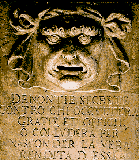 residence
and at the same time seat of many different political and
social institutions. The first floor was occupied by
minor institutions, such as the Avogaria or lawyers offices, where law cases were
examined; the Chancellery;
the Censors and Provveditori della Milizia del Mar (Naval Offices) which oversaw the care and equipping of
ships.
residence
and at the same time seat of many different political and
social institutions. The first floor was occupied by
minor institutions, such as the Avogaria or lawyers offices, where law cases were
examined; the Chancellery;
the Censors and Provveditori della Milizia del Mar (Naval Offices) which oversaw the care and equipping of
ships.The Grand Council chamber, the largest room of the palace, the Ballot chamber, where the committee met to elect the Doge, and the Doge's apartments are located on the second floor.
The Sala del Collegio, where foreign ambassadors were received, and rooms used by the state security service like the Council of Ten are located on the third floor.
 The
Bussola chamber is a small room with a box where citizens
could submit written complaints against other citizens.
The Sala dei Tre Capi (Three Chiefs Room) was used by
three components of the Council of Ten, who kept that
place only for one month. The State Inquisitor Room was
used to interrogate prisoners.
The
Bussola chamber is a small room with a box where citizens
could submit written complaints against other citizens.
The Sala dei Tre Capi (Three Chiefs Room) was used by
three components of the Council of Ten, who kept that
place only for one month. The State Inquisitor Room was
used to interrogate prisoners.